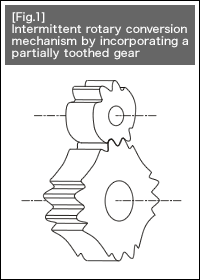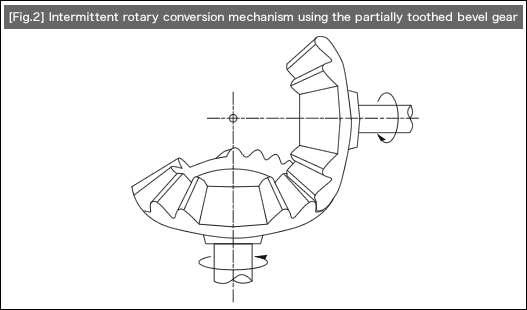#258 Basic Elements of Automation Clever Mechanisms: Intermittent Rotary Motion -1
This volume introduces an automation clever mechanisms that converts motion transmitted from the driving shaft rotating at a constant speed into intermittent movement involving periodical start and stop motion.
(1)Description of intermittent motion mechanism
| A partially toothed gear, which has a missing tooth, is used for the mechanism that converts uniform rotary motion into intermittent movement. (See [Fig.1].) This intermittent rotary motion mechanism using a partially toothed gear can transmit power and control the timing of rotary motion; however, there are some points to consider since this mechanism uses gear wheels. |
 |
=Cautions on adopting intermittent rotary mechanism using partially toothed gear=
Since the friction resistance between the two gears changes drastically when the intermittent motion starts and stops, be careful with the following:
| 1. | The part without a tooth should have a conical surface so that the gear wheels continue to rotate smoothly at a constant speed without causing positional misalignment of the next meshing teeth. | |
| 2. | It is best to incorporate a locking mechanism (such as nails or hooks) in order to avoid misalignment of the teeth of the driving shaft and the missing tooth part of the other gear when they come into contact. | |
| 3. | This structure is not suitable for fast rotating mechanisms owing to the impact applied during the start-up and stopping phase. |
(2)Typical example of this mechanism
[Fig.2] illustrates an application that uses the partially toothed shape of a bevel gear.

While the intermittent rotary conversion mechanism shown in [Fig.1] is a power transmission between the parallel axes, the transmission mechanism shown in [Fig.2] changes its axis direction to 90 degrees. To design this mechanism, remove a part of the teeth on the driving shaft of a bevel gear and process this part to have a conical surface. For the other gear as well, process the area that contacts the missing tooth part to have the same finish. Rotary motion occurs in the toothed area, but the gear wheel on the driven shaft side will stop when the missing tooth part is in contact with the other gear, thus transmitting intermittent motion.
In the next volume, we will look into the intermittent rotary motion mechanism using friction transmission, which is easier and more convenient than using toothed gears.
- Positioning technology
- Designing and processing
- Sensor Technology
- Automation elements technology
- Clean room technology
- Design hints
- Design tips
- Designing and Machining
- Drive mechanism design
- Hints on designing
- Linear Motion Components
- Locating Technology
- Manufacturing technology
- Motion mechanism design
- Pneumatic Drives
- Production Technology
- Technology Outlook
- General description
- Low-cost automation and materials
- Transfer LCA
- #333 Know-how on automation: Pressurized heating technology - 5: Multilayer pressurized heating process technique
- #332 Know-how on automation: Pressurized heating technology - 4: Points to remember when designing mechanism of pneumatic pressurization method
- #331 Know-how on automation: Pressurized heating technology - 3: Pneumatic pressurization method and pressure profile
- #330 Know-how on automation: Pressurized heating technology - 2: Pressurization method and pressure profile
- #329 Know-how on automation: Pressurized heating technology



